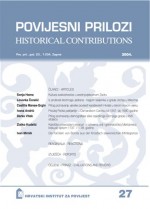Luc OREŠKOVIĆ. Les Frangipani. Un exemple de la réputation des lignages au XVIIe siècle en Europe. Cahiers Croates.
FRANGIPANE, Doimo – Ivan MIRNIK. The medals of the Frangipane. The Medal
Author(s): Ivan MirnikSubject(s): History
Published by: Hrvatski institut za povijest
Keywords: Frangipane family; counts of Krk; island of Krk; Middle Ages; Early modern period; Luc Orešković; genealogy
Summary/Abstract: The Frangipane were divided into three families. One of them blossomed in Rome, in Lazio and the Kingdom of Naples, the second in Croatia and the third in Friuli. Still, one cannot but discuss them as a unity, as their relations were always close and they considered themselves as kin, due to common origins, which remained undoubted through centuries, almost to our days. The very first notice to appear in documents known to us dates back to A.D. 1014, mentioning a certain “Leo qui vocatur Fragapane”, who acted as witness in an act preserved in the archives of the Farfa Abbey. Which means that the family already existed in the preceding century. Various annalists, historiographers and scholars have tried to prove that the family descended from the “Gens Anicia”. In which sense a genealogy was compiled by Onofrio Panvinio (*1529 +1568) in the sixteenth century, whereas Pietro Fedele made the Frangipane derive from the “de Imperatore”. We find the family in Rome and its vicinity from 1014 to 1654, the year in which Mario, Roman baron and the first Marquess of Nemi died in his palace erected in front of the Palazzo Venezia. Roman barons were a powerful Roman aristocratic class, who dictated laws in the City before the popes were invested with their temporal power. The count of Krk (Veglia) was in 1118 Doimo and from him derived the dynasty which grew with much magnificence in Croatia, in order to end with the death of Francis Christopher on 30 April 1671. In 1112 began the Friulan house with Federico di Caporiacco, a family still flourishing. From the start we must declare that Doimo and his offspring called themselves for a certain period only “Counts of Krk (Veglia)” and later on also of “Senj (Segna), Modruš (Modrusia) and Trsat (Tersatto)”, while the descendants of Federico in Friuli were called “of Caporiacco” or only “of Castello” and were known by this name in the Middle Ages. It was only much later, in the fifteenth century that both the Counts of Krk and the Lords of Castello officially used the second name Frangipane and for a brief period they used it while keeping the preceding name as predicates. In the Middle Ages it was usual to use the name of the possession or possessions, a habit still alive, particularly in some parts of Italy. The family left its imprint in Rome, Terracina, Marino, Cisterna, Taranto, Ortanto, Astura, Nettuno, Ninfa, Sezze, Grumo, Tolfa, Nemi and other places in Lazio and the Kingdom of Naples. It dominated Rome in the 11th and 12th centuries and owned major monuments, such as Circus Maximus, the Collosseum, the Arch of Titus, the Turris Cartularia, the Tomb of Caecilia Metella, which were turned into fortresses. They lived in the Caesars’ Palace on the Palatine and much later they built a magnificent palace at “San Marco”, where the last issue of the family died. They were divided into three branches: “da Chartularia”, “da Septizonio” (“da Settesoli”) and “da Gradellis”.
Journal: Povijesni prilozi
- Issue Year: 2004
- Issue No: 27
- Page Range: 167-182
- Page Count: 16
- Language: Croatian

